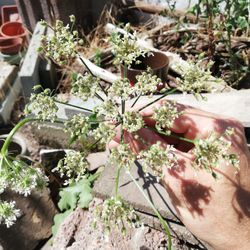No attributes recorded. For details refer to the original reference below.
"The plant is little used in modern herbalism but has been employed in the treatment of laryngitis and bronchitis[9, 238]. A tincture made from the aerial parts of the plant has also been used to relieve general debility, though it is uncertain how it works[7, 238]. The plant is harvested as it comes into flower and can be dried for later use[9]"
- PFAF References
"Many members of this genus, including many of the sub-species in this species[65], contain furanocoumarins. These have carcinogenic, mutagenic and phototoxic properties. See below for more details"
- PFAF References
"Root - cooked. It is usually boiled[7]."
- PFAF References
"The roots and the leaves are aphrodisiac, digestive, mildly expectorant and sedative[7, 9, 238]"
- PFAF References
"The leaf stems are tied in bundles and dried in the sun until they turn yellow[238]"
- PFAF References
"The roots and the leaves are aphrodisiac, digestive, mildly expectorant and sedative[7, 9, 238]"
- PFAF References
"Stem and young shoots - raw or cooked[5, 7, 9, 17]. Used as a green vegetable, when harvested just as they are sprouting from the ground they are somewhat like asparagus in flavour[183]. The rind is somewhat acrid[115]. The leaf stems are tied in bundles and dried in the sun until they turn yellow[238]. A sweet substance resembling sugar forms on the dried stems and is considered to be a great delicacy[2, 115, 183, 238]. The peduncles, before flowering, can be eaten as a vegetable or added to soups[183]"
- PFAF References

